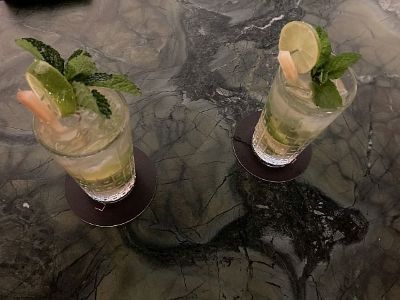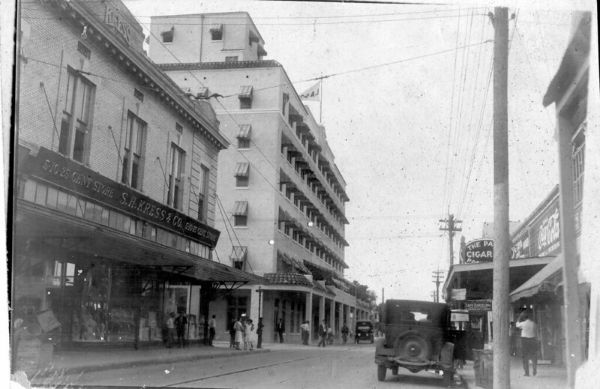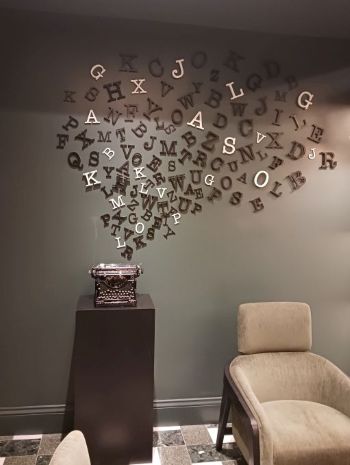“What would that bottle cost?” John asked.
We were at the Tropicado Mojito Bar, located inside the same building that, in April 1928, when Hemingway arrived aboard a ferry from Cuba, would have been his very first glimpse of downtown Key West. It was a view he later referenced in two short stories that became parts of his 1937 novel, To Have and Have Not, and was the same view we too had witnessed by boat earlier in the day: the seven-story La Concha Hotel rising up from the island.
We were determined to have a drink there.
Perched in the corner of the bar’s lighted top shelf was an elaborately boxed bottle of rum—one we both noticed because of the name “Ernest” emblazoned across its front, in Hemingway’s distinctive handwriting style.1 The friendly, dark-haired bartender pointed to the bottle and replied, “About a thousand bucks.”

With that exceeding our price range, we instead ordered two Signature Mojitos made with Papa’s Pilar blonde rum, named after the celebrated boat Hemingway purchased in 1934.2 The Hemingway Rum Company distills this distinct Key West spirit at the corner of Simonton and Greene Streets,3 close to the establishment that has become synonymous with Hemingway and his near decade on the island: Sloppy Joe’s Bar.
When our drinks arrived, garnished with the standard slices of lime and sprigs of mint, we were intrigued by the addition of oddly colored sticks protruding from each glass. “That’s sugar cane,” said the bartender, as we each took our first sip. “It’s a bit too sweet for me,” John whispered to Sharon, removing the sugar cane and setting it to the side. Sharon found the flavors and sweetness were nicely balanced, but also removed her length of sugar cane so the drink wouldn’t get any sweeter.

Enjoying our mojitos, we took in the atmosphere. The bar’s décor and the hotel lobby’s style easily fit the vision developer Carl Aubuchon had when plans were laid forth, in 1924, to build the most luxurious and tallest hotel south of Miami.
“Is there still a Hemingway Room in the hotel?” John asked the bartender.
“Oh, yes. There is a room and a suite. You’ll have to ask about them at the front desk.”
According to local lore, Hemingway had a favorite room at the La Concha, where he would often stay and write. It was in this room that he supposedly began (or wrote entirely, depending on who’s telling the story) To Have and Have Not.4 In reality, Hemingway most likely never stayed at the hotel, much less had a favorite room. But the hotel does indeed have a “Hemingway Suite,” located on the seventh floor. It is the largest and most exclusive of seven villas created when the top floor (which originally housed a dining hall) was converted from being used as a spa.5

Although Hemingway might not have been a guest at the La Concha (or, as it was known almost the entire time he associated with the island, the Colonial Hotel6), many within his orbit certainly stayed there. Visiting members of Hemingway’s “Key West Mob” enjoyed its inexpensive luxury accommodations and steak dinners.7 When Pauline (Pfeiffer) Hemingway’s father, Paul, arrived in Key West, on April 23, 1928, the Hemingways immediately put him up at the La Concha. It was also where Martha Gellhorn resided for nearly two weeks (and actually did work on a book) during her trip to Key West with her mother—a trip that brought about her “chance” meeting of Hemingway at Sloppy Joe’s original Greene Street location.8
Finishing our drinks, and having mentioned our interest in Hemingway and his connection to the hotel, we asked the bartender if we could look around a bit. “Of course,” he replied, and then gestured toward a nook off to the side, indicating it as being particularly worthy of our attention. We wandered over to the area, and were delighted to discover a kind of Hemingwayesque shrine. Shelves within wooden cases held a number of old, cloth-covered books (many dating back to the era of Hemingway’s youth) interspersed with various antique curios, and along the back wall, an old typewriter dating back to the 1930s sat on display—the wall behind it festooned joyfully with a jumble of black and white letters rising up from its platen.

On one of the shelves stood a plaque, on which Hemingway’s direct reference to the La Concha had been reproduced.9 It reminded us not only of our own view of the hotel from the water that afternoon, but how this island that Hemingway initially wanted so badly to leave became a place that inspired him and his writing, and how both had changed and influenced each other, under each other’s dynamics. For us, as visitors during the week of celebration around Hemingway’s birth known as Hemingway Days, and having seen “Papas” congregate at Sloppy Joe’s for the annual Hemingway look-a-like contest, it seemed appropriate to wind down our own time on the island by sharing a Key West experience Hemingway, too, had experienced—having a drink there.

1 In 2023 the Hemingway Rum Company released 400 bottles of the special “Ernest” rum, a concoction of three different rums, listed at a price of $599.00 per bottle. The rum sold out in under five hours.
2 “Blonde” rum is a unique creation of the Hemingway Rum Company.
3 The distillery sits inside what was once a tobacco warehouse, built in the 1870s.
4 It’s a story that makes little sense. Hemingway already enjoyed the exclusivity of a private writing studio at his Whitehead Street home—only four blocks from the La Concha.
5 According to the Key West’s Ghost City Tours, the Hemingway Suite is haunted, and is likely haunted by Ernest. This is improbable because the Hemingway Suite is one of seven other exclusive-to-the-seventh-floor villas that didn’t exist until decades after Hemingway had left both the island and this world.
6 Hemingway did stay at the Miami Colonial Hotel, in August 1937.
7 Rooms were around $3.00 a night, and steak dinners were an extra thirty-five cents.
8 The original Sloppy Joe’s Bar, where Hemingway drank from 1934 to 1938, is now known as Captain Tony’s.
9 In September 1930 the La Concha Hotel became the “Colonial Hotel” having been bought by the Miami-based Colonial Hotel Group. It would remain the Colonial Hotel for a number of years—well after Hemingway left the island—before returning to “La Concha.” In his writing, Hemingway chose to refer to the hotel by its original name. One has to wonder if, for fellow Key Westers, this was a way of dating the action in his story.
Sharon Hamilton is a member of the Hemingway Society Board. She has blogged previously for the Hemingway Society about visiting Hemingway and Hadley’s Chicago Apartment and about Hemingway’s New Orleans.
John Hargrove is a Michigan-based writer and Hemingway researcher; he is also the founder of "Ernest Hemingway: The True Gen," an online community of Hemingway researchers and aficionados hosted on social media. He has blogged previously for the Hemingway Society about Hemingway's Socket Photo and Hemingway's High Carnival Next, a very early newspaper article.
Together, Hamilton and Hargrove have blogged about Hemingway in Buffalo, Wyoming; Pamplona, Spain; and Petoskey, Michigan. Their most recent post described their visit to Hemingway's Key West apartment.